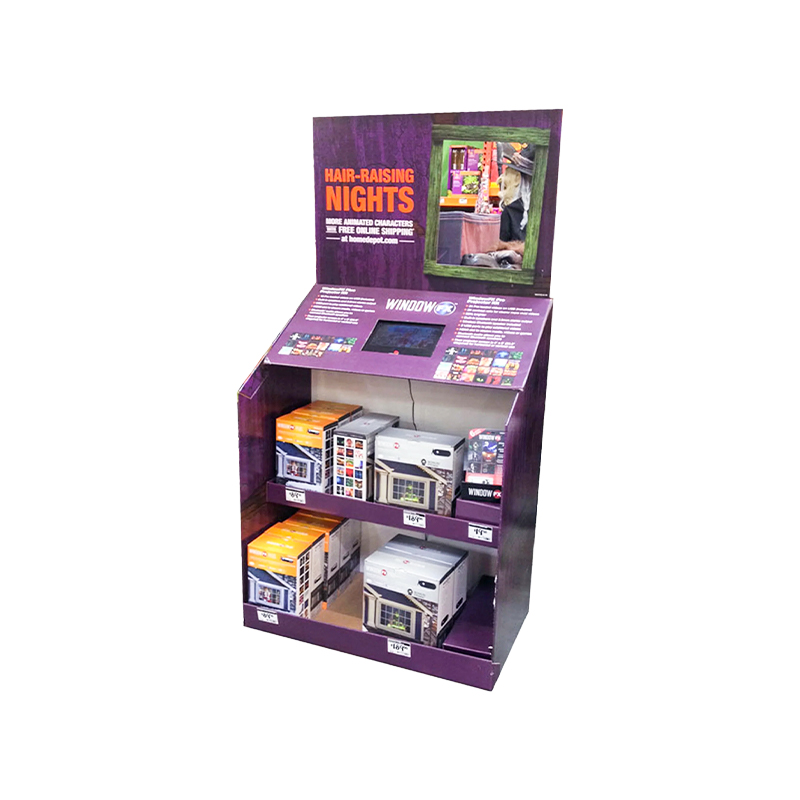-
 +86-0557-3781111 / +86-0571-56396277
+86-0557-3781111 / +86-0571-56396277
 +86-0557-3781111 / +86-0571-56396277
+86-0557-3781111 / +86-0571-56396277
Creating multi-functional cardboard displays that serve both as shelving and point-of-sale (POS) promotional tools requires careful consideration of several factors to ensure they are both practical and effective in a retail environment. Here are the key considerations for designing these versatile displays:
1. Structural Integrity and Load Capacity
Consideration: The display must be strong enough to support the weight of the products without compromising its shape or stability.
Action: Use reinforced cardboard or double-wall corrugated board in key areas, such as shelves and base supports, to handle heavier products. The design should distribute weight evenly and include bracing mechanisms or internal supports to avoid sagging.
Outcome: The display can hold products securely while maintaining the ability to function as a POS tool.
2. Modular Design
Consideration: Flexibility and adaptability are key. A modular design allows the display to be easily reconfigured to fit different product types or retail spaces.
Action: Incorporate interlocking parts or stackable elements that allow the display to be adjusted in size and shape. This helps accommodate varying product heights and provides flexibility for seasonal or promotional changes.
Outcome: The display can evolve based on changing needs, from standard shelving to a promotional setup for new products.
3. Ease of Assembly and Disassembly
Consideration: The display should be easy to assemble and disassemble to save time during setup and minimize disruption in the store.
Action: Use pre-scored folding lines, interlocking tabs, and tool-free assembly methods. Instructions should be clear and simple for store staff to follow.
Outcome: Quick and efficient assembly, reducing labor costs and allowing for seamless transitions between shelving and promotional use.

4. Attractive and Effective Branding
Consideration: Since the display also serves as a point-of-sale tool, it should effectively communicate the brand's message and encourage consumer interaction.
Action: Integrate eye-catching graphics, clear branding elements, and promotional messaging into the design. High-quality printing techniques like digital printing or flexographic printing can be used for sharp, vibrant visuals.
Outcome: The display draws attention and reinforces the brand, increasing the likelihood of consumer engagement and impulse purchases.
5. Integration of POS Features
Consideration: The display should include features that facilitate point-of-sale transactions, such as shelf talkers, QR codes, or interactive displays that encourage customers to make purchases or engage with digital content.
Action: Design spaces or attachments for digital screens, price tags, or product information panels that align with the brand's goals. QR codes can also be added to offer discounts or drive traffic to online platforms.
Outcome: Enhanced customer experience and seamless integration with the sales process.
6. Visibility and Accessibility
Consideration: Both shelving and promotional functions require that products are easily visible and accessible to customers.
Action: Arrange shelves at appropriate heights and angles to maximize visibility. For products that need to be easily grabbed, ensure easy-to-reach levels and open-front shelving.
Outcome: Products are presented in a way that increases customer interaction and facilitates easy browsing and purchasing.
7. Space Efficiency and Footprint
Consideration: The display should maximize the use of available retail space while minimizing its footprint.
Action: Optimize shelf spacing and stacking arrangements, making sure the display fits within designated floor space while offering a compact design. Multi-tier designs can help increase shelf space while keeping the display within a manageable size.
Outcome: Efficient use of floor space, accommodating more products and creating a visually appealing, organized display.
8. Durability and Longevity
Consideration: Since the display serves dual functions, it needs to endure both the weight of products and the potential wear and tear from frequent handling and repositioning.
Action: Use high-quality corrugated materials with appropriate finishes, such as lamination or water-resistant coatings, to increase durability. Reinforce areas that are subject to higher wear, such as edges and corners.
Outcome: The display lasts longer, maintaining its structural integrity through the duration of its use in-store.
9. Ease of Maintenance and Cleanliness
Consideration: Retail displays, especially those used for promotions, need to be easy to clean and maintain to keep them looking fresh and appealing.
Action: Choose cardboard materials that resist dirt accumulation and fingerprints. Design the display so that it can be easily wiped down or cleaned without damaging the surface or graphics.
Outcome: The display stays presentable and retains its visual appeal throughout its use.
10. Environmental Impact and Sustainability
Consideration: Consumers and retailers alike are increasingly concerned with sustainability. The display design should reflect eco-friendly practices.
Action: Use recyclable, biodegradable, or recycled materials. Consider designing the display for easy disassembly to facilitate recycling after use. Labels or messaging about the environmental benefits can also be added to reinforce sustainability.
Outcome: The display aligns with consumer values and enhances the brand's environmental credibility.
11. Cost-Effectiveness
Consideration: The display must offer value for money while maintaining high functionality and visual appeal.
Action: Use efficient material sourcing, optimized production processes, and minimal design complexity to keep costs manageable. Consider bulk production to reduce unit costs, but balance this with the need for customization and flexibility.
Outcome: The display delivers strong performance at a reasonable price point, making it cost-effective for both the manufacturer and retailer.
12. Adaptability to Different Retail Environments
Consideration: The design must be adaptable to various types of retail spaces (e.g., grocery stores, fashion stores, electronics outlets).
Action: Ensure the display can be adjusted to different retail layouts, considering factors like store size, aisle width, and consumer traffic patterns. Portable or collapsible designs can also be beneficial for temporary retail setups.
Outcome: The display can be effectively used across multiple retail channels, whether permanent or pop-up.
Annhiu Address: Yishan Road and Qingshengou Road Intersection, Suzhou Economic Development Zone, Anhui, China
Tel: +86-0557-3781111
E-mail: [email protected]
Hangzhou Address: Building 3, No.286, Renliang Road, Renhe Street, Yuhang District, Hangzhou, Zhejiang, China
Tel: +86-0571-56396277
E-mail: [email protected]
Copyright © Hangzhou Shengpin Packaging Co., Ltd. All Rights Reserved.
